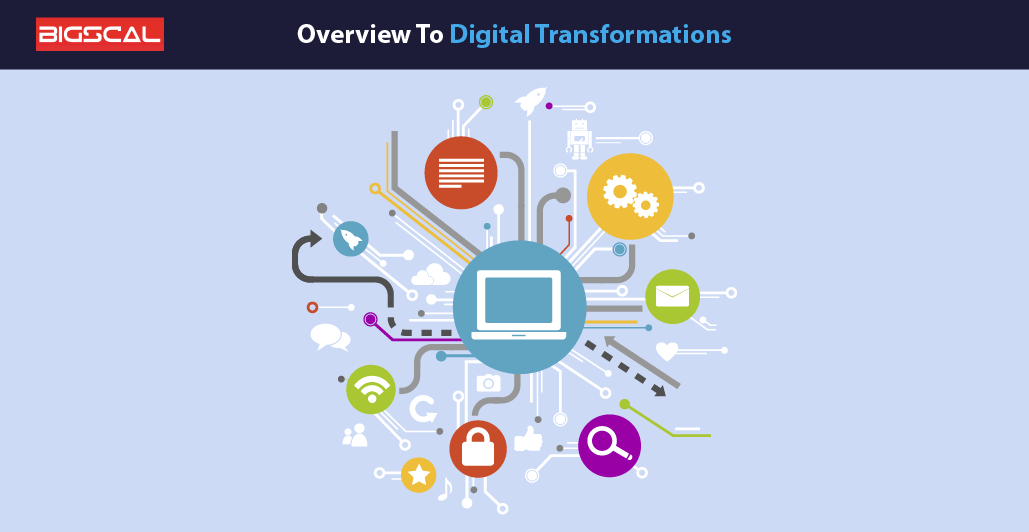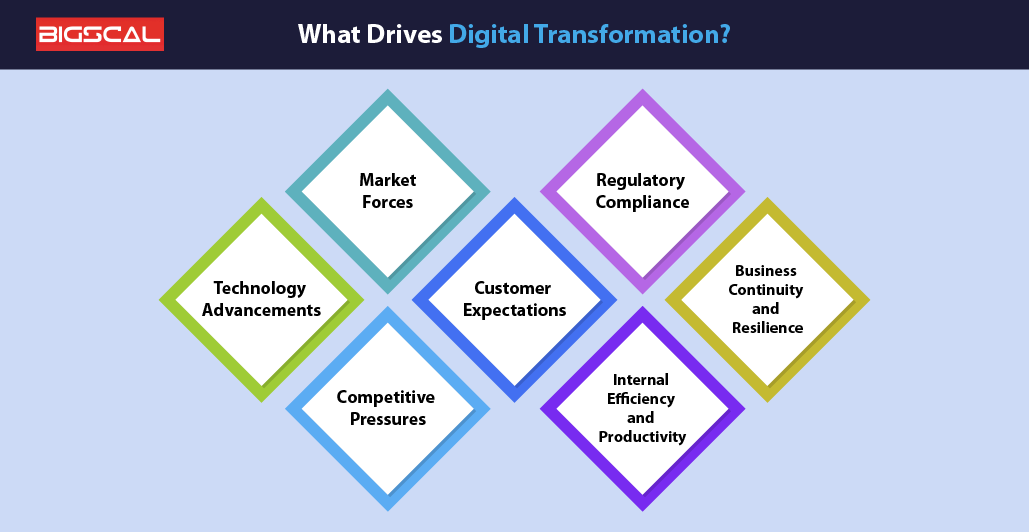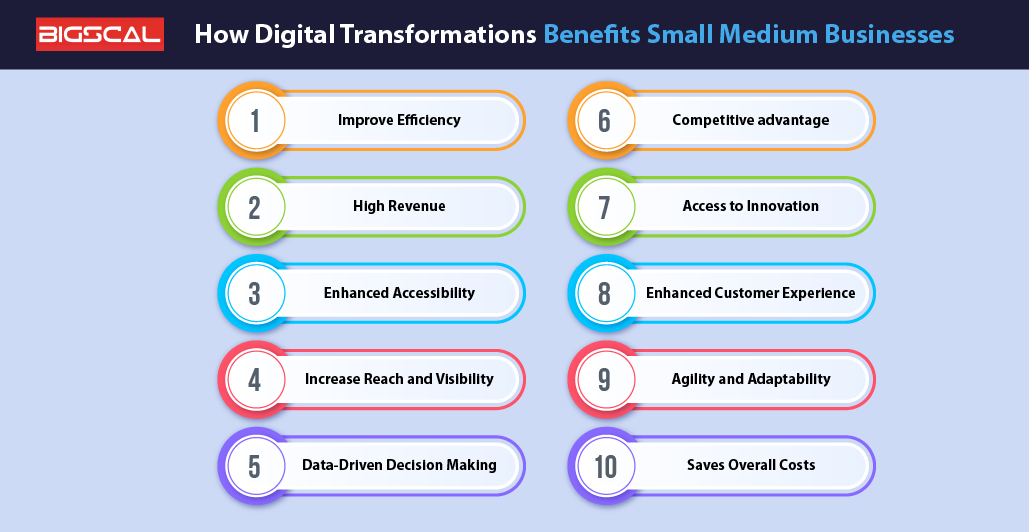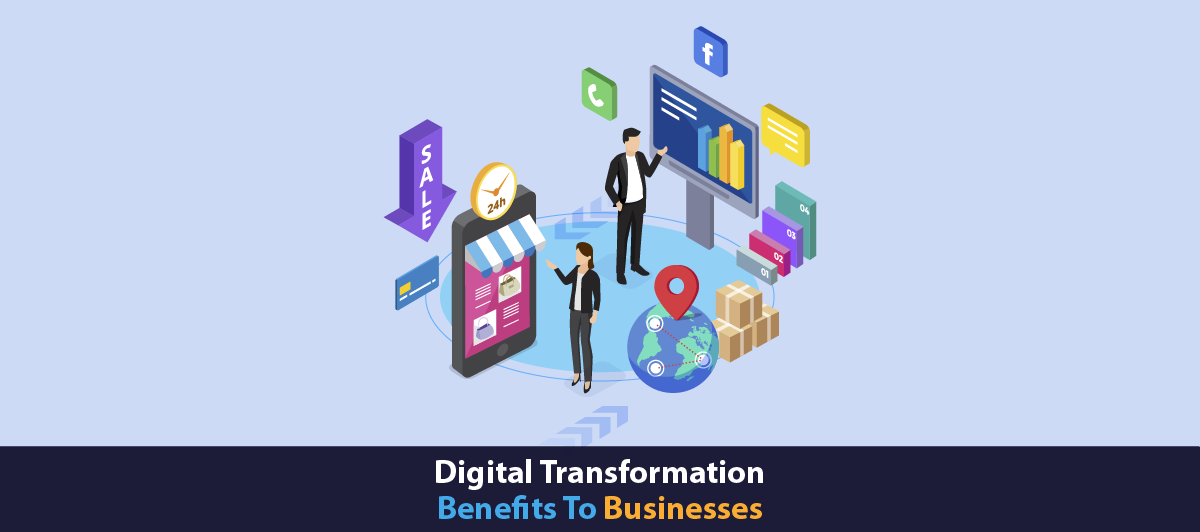How Digital Transformation Benefits Small Medium Businesses In 2024
Quick Summary: As technological advancements increase, business processes get digitize and they have to make technology investments. But why? In this article we will discuss how Digital Transformations benefit Small Medium Businesses. It will be helpful for you to understand why you might need to adopt digital innovations. And why it is now a main part of business models. So keep reading!
Introduction
Digitization is no longer an option for business, this is the thing that brightens the business future. Small- and medium-sized enterprises (SMEs) of 2024 shall not only follow the prevailing trend. Digital Transformation Benefits the businesses reinvent their business models in order to exist and prosper in the modern world economy.
The digital transformations aren’t limit within the introduction of new technologies. It is all about recreate the processes and business models in alignment with the digital age to get the benefit of the digital era. Through cloud computing and data analytics, artificial intelligence and automation. SMBs have the tools that can completely change the way they work and interact with their customers.
Be it a small retailer, local service provider or growing startup, to stay in the race of modern day digital world Every business needs to adopt it…
But What are its benefits and why businesses need to adopt Digital Transformation Services!
Read it on!
Overview To Digital Transformations

Digital transformation is the process of incorporating digital technology into all the aspects of an organization. It makes it run and delivers its value to its customers in a completely different way. This is not only adopting and replacing and replacing new technologies. It incorporates transformation in the organizational culture as well as the very style in which the people think.
Goals of the digital transition process are to increase profits by utilizing new efficiencies. Additionally, it enhances customer experiences and provides innovative solutions to customers in order to conquer the digital world. Digital transformation benefits much more than just about using emerging technologies. These are artificial intelligence, cloud computing, big data analytics, Internet of Things (IoT), and automation.
These technologies are the key engines that help corporations to initiate, capture, and capitalize on mountains of data in real-time. Which can yield intelligence that can be used for controlling the flow of decision-making and optimizing work processes. By utilizing such technologies, companies can be able to combine the traditional and modern approaches and way of doing things thus easily managing operations. It reduces costs and improves accurate delivery of products and services.
The needs of modern customers require omni-channel services that assure smooth and personalization interaction. They need to be sure that they have immediately available information, deals can be completed with ease, and they get a prompt response. In order to fulfill these demands, companies have to digitize their procedures, allocate resources to digital channels, and use data-driven insights to provide personalized and timely services.
What Are Small Medium Businesses?

Medium and small enterprises (SMEs), the common term that describes the companies with small numbers of staff and which generate less revenue. Whereas larger corporations, are commonly popular as small and medium-sized businesses (SMBs). The specific background of an SME is sometimes different in other countries and sectors but these usually do not exceed some of the limits regarding revenue, assets and employment sizes.
For instance, in the European Union, a business regard as an SME if it has fewer than 250 employees. And either an annual turnover of up to €50 million or an annual balance sheet total of up to €43 million. In the US, as per the definition by Small Business Administration (SBA), small business is set by the boundaries such as industry requirements like annual revenue and number of employees.
SMEs are main contributors to jobs in various economic areas by way of output, innovation, and employment generation. In most cases, they are more flexible and adaptable than big corporations, which makes them able to react to the changes in the market faster. However, it is not all as easy as it seems – they also have to struggle with a lack of relevant capital, difficulty of gaining access to financing, and competition from the large companies.
What Drives Digital Transformation?
Before understanding the Digital Transformation benefits, let’s first understand what drives digital transformation:

Market Forces
The digital transformation is frequently initiated by the changes in the market. This can mean shifting the consumption behaviour, the rising of emerging markets or the transform of the world economy. For example, the case if the online platform is growing people have to transform into digital and the business can be competitive. Market forces in a way force organizations to adapt and transform themselves to stay in touch in their field.
Technology Advancements
Technology advancements shift the focus of organizations to successful digital transformation. New technologies such as artificial intelligence, blockchain, and the Internet of Things (IoT) open doors for firms to automate their operations, improve efficiency, and invent new products or services. With the technology progressing, organizations have to grasp these advances to keep up with the pace and use them to improve their business processes.
Competitive Pressures
The current customer expects to consume all channels perfectly digital. Whether it’s buying stuff online, getting customer support, or communicating with a brand on social media, people expect convenience, personalization, and responsiveness. In order to meet the these requirements, companies need to undertake digital transformation initiatives that concentrate on strengthening customer experience and adding value at each customer contact.
Customer Expectations
The current customer expects to consume all channels perfectly digital. Whether it’s buying stuff online, getting customer support, or communicating with a brand on social media. People expect convenience, personalization, and responsiveness. In order to meet these requirements, companies need to undertake digital transformation initiatives. These initiatives concentrate on strengthening customer experience and adding value at each customer contact.
Regulatory Compliance
Changes in the regulatory requirements and compliance standards are shifting rapidly, in particular in the sectors of finance, healthcare and telecommunications. Non-compliance can involve huge fines, legal problems, and damage to reputation. Digital transformation allows organizations to build a framework and a mechanism to comply with new rules while increasing efficiency and transparency. The use of digital technology gives businesses the chance to master regulatory compliance and significantly cut down on the risk of non-compliance fines.
Internal Efficiency and Productivity
Digital transformation strategies are mostly caused by the changes in the market. Therefore, we could see changes in consumer habits, emergence of long-term markets, as well as improvement in globalomy. For example, such a demand for online retailing may be activating the need for a digital connection, so businesses have to digitize to compete better. Market forces in fact basically drive organizations to be flexible and change to be competitive in their field.
Business Continuity and Resilience
The digital transformation strategy is one of the main factors that are shaping the technology-driven digital transformation. Nowadays advanced technologies such as AI, blockchain, machine learning, and IoT help companies operate more effectively, save time and create new products or services. With the ever-growing technology. These organizations have to keep up with these developments to stay in the lead and use them to improve their business processes.
How Digital Transformations Benefits Small Medium Businesses
Here are the advantages of digital transformations in Small Medium Businesses. These benefits would help you to understand why you must adopt digital solutions and digital technologies. For example, Cone Accounting Practice Management Software helps accountants to improve efficiency and client experience. Have a look:

Improve Efficiency
It is the major benefit of integrating digital technologies into your business applications or create Digital Transformation In Healthcare or Digital Transformation In Oil And Gas. Digital tools such as software programs and automation accelerate routine work tasks. It helps to achieve them effortlessly. To illustrate the usage of technology, for instance, instead of traditional manual inventory tracking, digital inventory management software can automatically update the stock levels.
Moreover, with sent media and messaging apps at their disposal, people find it more convenient to come together whether they are coiled together in the same space or scattered abroad. This translate into the rapidity of the decision-making and elimination of the snags in the workflows. In short, through the enhancement of efficiency, SMBs can accomplish more in less time. Thus, having more time to do more important stuff that will help them to grow their business. For many SMBs, digital transformation starts with overcoming a key challenge: access to growth capital. Understanding small business financing like SBA loans, their terms, and application process empowers SMBs to adopt new technologies, expand, and improve operations.
High Revenue
The digital transformation of SMBs also result in higher income similar to those recorded in large corporations. Through the use of ecommerce platforms and digital marketing tactics, businesses can tap into the largest group of consumers they have ever had access to at that moment. They will be able to sell their products or services not only to the local customers but also to the people all over the world.
Moreover, the data analytics tools can help the organizations in understanding their customers better and in this way, they can add values to their products. This could be one of the reasons why customers are so satisfied and often return, as well as make more sales. In addition, digital transformations can simplify the sales process, making it easier for customers to buy things quickly and easily. Total effect of these factors on a small and medium business (SMB) pursuing the digital transformation can bring a very impressive raise in revenue.
Enhanced Accessibility
Digital revolution is a driver of small and midsize businesses by making their products and services available to grow their client base. For example, anyone can reach a business who has an internet connection on the web, at any time and from any place.
This, therefore, implies that the customers do not need to go to the brick-and-mortar store to make a purchase or query about specific products. Digital tools like mobile apps will not be left behind in this accessibility. They will allow the customers to interact with the business conveniently from their phones or tablets. Businesses can be more easily accessible to people who cannot visit a physical store because of mobility issues or geographical distance.
Increase Reach and Visibility
Another Digital transformation benefit is it increases the range and reach of small and medium enterprises. Online marketing strategies such as social media advertising, SEO, and email marketing. These can help businesses in attracting prospective customers from beyond their local area.
Through the platforms of digital marketing, companies can reach the audience they are targeting and their marketing efforts. It will definitely be seen by the right people. Tools like email campaign software allow marketers to create, schedule, and analyze personalized email outreach, enhancing engagement and conversion rates. Using email marketing tools to create custom HTML email templates can increase reach and visibility, making it a strategic move for any marketing campaign. Nevertheless, digital channels also tend to provide analytic tools that show campaigns effectiveness. So, the companies can decide on the right actions to reach better results. With the increased broadcasting and visibility, this will create a bigger platform to tie the customers in and make the business grow, ultimately leading to an increase in sales and profitability.
Data-Driven Decision Making
The digital transformation journey gives small and medium businesses (SMBs) the means to gather and process data quickly. Rather than making assumptions on prior experiences SMBs now have the option to base their decisions on quality data analytics. They can get quick key performance indicators.
To mention a few, the retailers can explore their buyers’ purchasing behaviors to determine which products are the most popular. And react by adjusting their inventory. This data-driven method eliminates the guesswork and increases the probability of making decisions that will lead to growth and success. It’s just like having a personal GPS for your business decision making. Thus you get live-time information instead of referring to old maps.
Competitive advantage
Digital revolution evens up the playing field for small and medium-sized businesses. It makes them able to compete on equal terms with the giants. Through the use of digital tools such as e-commerce platforms, social media marketing, and customer relationship management (CRM) systems. SMBs can reach a larger audience and offer personalized experiences to customers.
This agility and adaptability enable SMBs to remain quick on their feet. Thus, outsmarting the big fish in the industry. The digital transformation of SMBs allows them to achieve two goals. These speed up their operations and accordingly cut down costs, and so they are qualified to win the competition.
Access to Innovation
Digital transformation mostly represents a new space offered to SMBs. It is simply like handing them the keys to unlock the resourcefulness of innovation. By using digital tools and technologies, SMBs can make their operations more efficient. Cut the number of repetitive tasks they have to do, and stay up to date in their industries. For example, cloud computing makes it possible to get the software and computing power one requires without the need for large start-up costs. This enables any size business to leverage powerful tools that used to have cost thousands of dollars.
Besides that, digital transformation benefits SMEs with the latest trends and technologies like artificial intelligence and data analytics. They help to get insights about their customers, optimize their processes and make better decisions. Many SMBs are also adopting tools to manage innovation portfolio, ensuring they prioritize and track initiatives that deliver the highest value. Through digital transformation, SMBs can make up for the size disadvantage they have against the major ones. And they compete fiercely on the strong front of innovation and development.
Enhanced Customer Experience
The digital transformation efforts is not only about smart devices, it is about serving a customer demands with ease. The SMBs can use digital tools to offer a seamless and personalized service to their customers. Instance, the Internet shops and mobile applications help companies to be at hands of customers all the time and everywhere.
The buying process becomes more convenient. On the other hand, with data analytics, small businesses can recognize what their customers like and also their behavior. It is important in a way of adjusting products and services to their liking. Moreover, digital communication channels such as social media and chatbots allow SMBs to interact with their customers in real-time. Thus, they can provide support and assistance whenever it is needed.
Apart from that, this could build customer loyalty, while developing trust and further enhancing the business – customer relationship. However, through digital transformation, SMBs can stand out from the competition. Build formidable relationships with their audience by focusing on improving the customer experience.
Agility and Adaptability
When you embrace digital transformation, you empower it to take its own, unpredictable course, just like that gymnast does on that mat floor. Once your company adopts graphic and electronic techniques, the organization will become more mobile and flexible.
As an example, if there is a sudden increase in demand for your product, digital systems can assist you in scaling up production. With a quick adjustment of marketing strategies so as to accommodate that demand. Pivoting also means that you will be able to react quicker to the market conditions. You will also be able to outdo your competitors by innovating and better serving your customers.
Saves Overall Costs
Digital transformation can be seen as a smart accountant for your company. Automation of repetitive operations, streamlining workflow, and improvement of efficiency. Hence, it allows businesses to reduce expenses on unessential things. As an example, cloud-based solutions could cut hardware as well as IT infrastructure costs. While online team collaboration platforms might prevent travel or even office space costs.
In addition, digital transformation leaders enhance data management and analytics. It makes you able to make the right decisions that will help you utilize your resources effectively and minimize waste. Among the factors, initial investments in technology are the ones that can instantly be paid off. So, this is the smart option for small and medium businesses aiming to have sustainable growth.
How Bigscal Can Create Digital Transformation With Thier Software
If you are looking for a company to provide you with successful digital transformation benefits with the software and tools. Then you must consider Bigscal Technologies Here’s why;
We at bigscal technologies provide the best solutions that need for digital transformation. Our software systems are highly innovative and helps businesses to changing the way they work. Thus, it makes them more efficient and innovative. The implementation of automation in repetitive tasks or the integration of the various systems. It provide smooth workflow are some of the strategies to ensure continuous operations without interruptions.
Besides, we concentrate on the use of data. Our software gathers and processes data to create knowledge, and in turn, helps all our customers make informed decisions. We supply businesses with insights on customer behaviors, market patterns, and others that are designed to leverage their data for growth and success.
Moreover, we pay special attention to the scalability and the flexibility. With business operations expanding or with costs or client demands changing. Our adaptable software is our unique selling proposition. For us, the companies are in the future of the digital world, which is fast and intense, and able to adapt and compete.
Conclusion
So, Ultimately, digitalization for small- and medium-sized businesses in 2024 brings about a series of benefits. Adopting technology will enable SMBs to gain efficiencies, reduce the costs and also serve their clients better. The advantages are immense from the increased online presence to the data-driven insights. In addition, by implementing digital tools small businesses begin to compete more equally with their respective large companies. In the modern era, which is full of speed and busy schedules. Not realizing digital transformations is not just being a winning factor but a vital tool for the future progress.
FAQ
What is an example of a digital transformation process?
One of the processes of digital transformation is a retail store that has only a physical store. Now it is implementing an e-commerce platform. Integrating inventory management, online sales, and customer relationship management systems.
What is digital transformation for business?
Digital transformation in business is about using digital technologies to reshape the conventional thinking of firms at all levels of operations. It shifts their business strategies and adds value to customers, employees, and all other stakeholders. This embraces the IT field of using technology to help optimize operational processes. It increases efficiency, better customer service, and facilitates innovation.
What are the 5 As to digital transformation for organizations?
The 5 As framework for digital transformation in organizations typically includes:
- Awareness: The realization that the time has come to shift the focus towards digital transformation and being aware of the advantages and difficulties of the process.
- Alignment: Guaranteeing that the digital projects are in coordination with the company’s long-term goals, strategies in approach, and culture.
- Adoption: Motivating organization-wide digitalization that pervades at every level from the top management to the lower hierarchy.
- Adaptation: This process is never ending and it is driven by the need to adopt new technologies, market trends, and customer preferences.
- Accountability: Being inclusive and making the people driving digital transformation understand that every step must be accountable for impacting business outcomes.
What is robotic process automation?
Robotic Process Automation is a technology that makes use of software robots or “bots” to automate repetitive tasks. Tasks with rules that humans perform earlier. These robots can resemble human actions to interact with digital systems. For instance, they can log into applications, copy and paste data, and fill out forms. RPA desires to automate the workflows, enhance the efficiency of work, and cut down the human error subject to the processes in industries from different fields.
What are the 3 factors of successful digital business transformation?
Three key factors for successful digital business transformation are:
- Leadership and Vision: A strong leader with also a clear vision for digital transformation is paramount. Leaders should be the ones at the forefront of the change. It makes sure the organization’s goals are in line with digital initiatives and creating a culture of innovation and adoption.
- Talent and Skills: Team with the right skills and experience in digital technologies is a major factor in the success of our digital transformation. This, however, goes beyond only technical skills. it also includes the ability to drive change, to collaborate on various functions across the board. As well as to never stop learning more.
- Agile and Flexible Infrastructure: The digital system is flexible and scalable. Which allows for the fast adjustment to the changing market dynamics and customer needs. This involves cloud computing, data analysis. The introduction of new technologies such as AI and IoT that will facilitate innovation and development.





